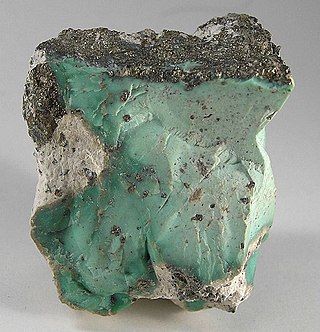
Variscite is a hydrated aluminium phosphate mineral (AlPO4·2H2O). It is a relatively rare phosphate mineral. It is sometimes confused with turquoise; however, variscite is usually greener in color. The green color results from the presence of small amounts of trivalent chromium (Cr3+
).

Adamite is a zinc arsenate hydroxide mineral, Zn2AsO4OH. It is a mineral that typically occurs in the oxidized or weathered zone above zinc ore occurrences. Pure adamite is colorless, but usually it possess yellow color due to Fe compounds admixture. Tints of green also occur and are connected with copper substitutions in the mineral structure. Olivenite is a copper arsenate that is isostructural with adamite and there is considerable substitution between zinc and copper resulting in an intermediate called cuproadamite. Zincolivenite is a recently discovered mineral being an intermediate mineral with formula CuZn(AsO4)(OH). Manganese, cobalt, and nickel also substitute in the structure. An analogous zinc phosphate, tarbuttite, is known.

Triplite is a rare phosphate mineral with formula: (Mn, Fe)2PO4(F, OH). It occurs in phosphate-rich granitic pegmatites typically as irregular brown opaque masses. Triplite was first described in 1813 for an occurrence in Chanteloube, Limousin, France. The name is from the Greek triplos for triple, in reference to the three cleavage directions. In color and appearance, it is very similar to rhodocrosite, another manganese bearing mineral. Chemically, it is also quite similar to triploidite the difference being that triplite is fluorine dominant while triploidite is hydroxide dominant.
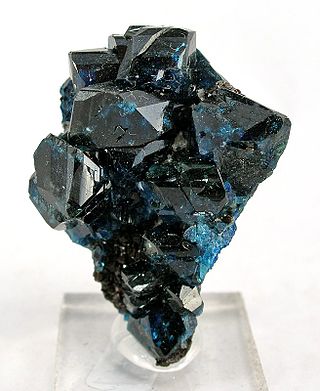
Lazulite ((Mg,Fe2+)Al2(PO4)2(OH)2) is a blue, phosphate mineral containing magnesium, iron, and aluminium phosphate. Lazulite forms one endmember of a solid solution series with the darker iron rich scorzalite.

Lithiophilite is a mineral containing the element lithium. It is lithium manganese(II) phosphate with chemical formula LiMnPO4. It occurs in pegmatites often associated with triphylite, the iron end member in a solid solution series. The mineral with intermediate composition is known as sicklerite and has the chemical formula Li(Mn,Fe)PO4). The name lithiophilite is derived from the Greek philos (φιλός) "friend", as lithiophilite is usually found with lithium.
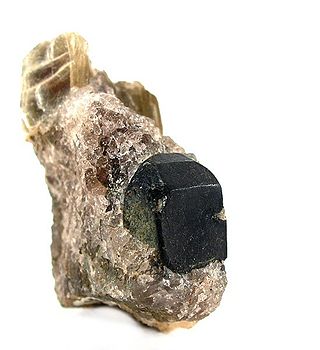
Triphylite is a lithium iron(II) phosphate mineral with the chemical formula LiFePO4. It is a member of the triphylite group and forms a complete solid solution series with the lithium manganese(II) phosphate, lithiophilite. Triphylite crystallizes in the orthorhombic crystal system. It rarely forms prismatic crystals and is more frequently found in hypidiomorphic rock. It is bluish- to greenish-gray in color, but upon alteration becomes brown to black.

Seamanite, named for discoverer Arthur E. Seaman, is a rare manganese boron phosphate mineral with formula Mn3[B(OH)4](PO4)(OH)2. The yellow to pink mineral occurs as small, needle-shaped crystals. It was first discovered in 1917 from a mine in Iron County, Michigan, United States and identified in 1930. As of 2012, seamanite is known from four sites in Michigan and South Australia.

Eucryptite is a lithium bearing aluminium silicate mineral with formula LiAlSiO4. It crystallizes in the trigonal - rhombohedral crystal system. It typically occurs as granular to massive in form and may pseudomorphically replace spodumene. It has a brittle to conchoidal fracture and indistinct cleavage. It is transparent to translucent and varies from colorless to white to brown. It has a Mohs hardness of 6.5 and a specific gravity of 2.67. Optically it is uniaxial positive with refractive index values of nω = 1.570 - 1.573 and nε = 1.583 - 1.587.
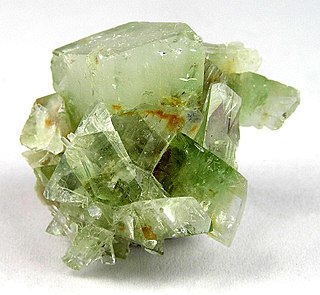
Augelite is an aluminium phosphate mineral with formula: Al2(PO4)(OH)3. The shade varies from colorless to white, yellow or rose. Its crystal system is monoclinic.

Eosphorite is a brown (occasionally pink) manganese hydrous phosphate mineral with chemical formula: MnAl(PO4)(OH)2·H2O. It is used as a gemstone.

Santabarbaraite is an amorphous ferric hydroxy phosphate mineral hydrate that was discovered in Tuscany, Italy during 2000. It also can be found in Victoria, Australia and Lake Baikal, Siberia.

Beraunite is an iron phosphate mineral. It was first described by August Breithaupt for an occurrence in Beraun currently in the Czech Republic. Beraunite occurs as a secondary mineral in iron ore deposits, and as an alteration product of primary phosphate minerals in granite pegmatites.

Cyrilovite (NaFe33+(PO4)2(OH)4·2(H2O)) is a hydrous sodium iron phosphate mineral. It is isomorphous and isostructural with wardite, the sodium aluminium counterpart.
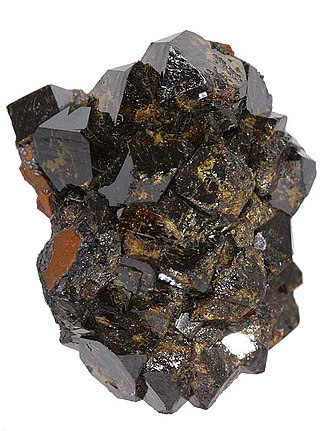
Beudandite is a secondary mineral occurring in the oxidized zones of polymetallic deposits. It is a lead, iron, arsenate, sulfate with endmember formula: PbFe3(OH)6SO4AsO4.
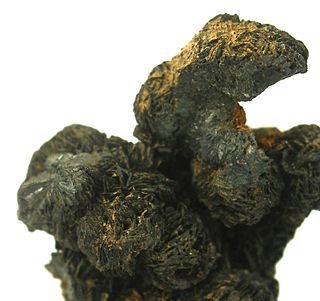
Hagendorfite is an iron phosphate mineral with the chemical formula of (Na,Ca)MnFe2(PO4)3 and is named after where the mineral was discovered, Hagendorf-Süd, Bavaria, Germany.

Ludlamite is a rare phosphate mineral with chemical formula (Fe,Mn,Mg)3(PO4)2·4H2O. It was first described in 1877 for an occurrence in Wheal Jane mine in Cornwall, England and named for English mineralogist Henry Ludlam (1824–1880).

Allanpringite is a phosphate mineral named after Australian mineralogist Allan Pring of the South Australian Museum. Allanpringite is a Fe3+ analogue Al-phosphate mineral wavellite, but it has a different crystal symmetry – monoclinic instead of orthorhombic in wavellite. It forms needle-like crystals, which are always twinned and form parallel bundles up to about 2 mm long. They are often found in association with other iron phosphates in abandoned iron mines.
Gatehouseite is a manganese hydroxy phosphate mineral with formula Mn5(PO4)2(OH)4. First discovered in 1987, it was identified as a new mineral species in 1992 and named for Bryan M. K. C. Gatehouse (born 1932). As of 2012, it is known from only one mine in South Australia.
Bobfergusonite is a mineral with formula Na2Mn5FeAl(PO4)6. The mineral varies in color from green-brown to red-brown. It was discovered in 1986 in Manitoba, Canada, and named for Robert Bury Ferguson (born 1920). As of 2012, the mineral has only been found in Canada and Argentina.

Serrabrancaite is a mineral with the chemical formula MnPO4•H2O and which is named for the locality where it was found, the Alto Serra Branca Pegmatite. The Alto Serra Branca mine has been in operation since the 1940s. It is located in Paraiba, Brazil near a village named Pedra Lavrada. Tantalite is the main mineral mined here. Specimens of serrabrancaite are kept in the Mineralogical Collections of both the Bergakademie Freiberg, Germany and the Martin-Luther Universität Halle, Institut für Geologische Wissenschaften.


















